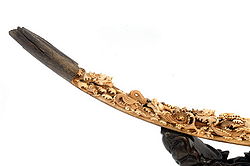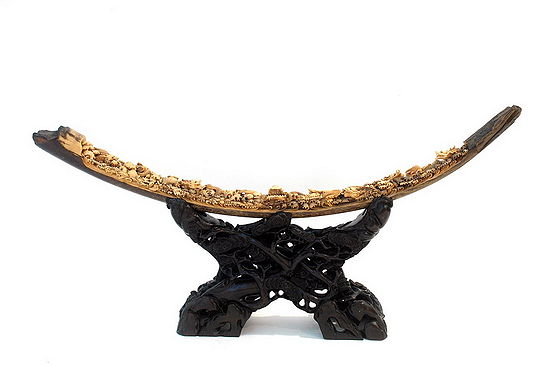
Elephant and mammoth ivory
Encyclopedia

Order (biology)
In scientific classification used in biology, the order is# a taxonomic rank used in the classification of organisms. Other well-known ranks are life, domain, kingdom, phylum, class, family, genus, and species, with order fitting in between class and family...
Proboscidea
Proboscidea
Proboscidea is a taxonomic order containing one living family, Elephantidae, and several extinct families. This order was first described by J. Illiger in 1881 and encompasses the trunked mammals...
. Mammoth
Mammoth
A mammoth is any species of the extinct genus Mammuthus. These proboscideans are members of Elephantidae, the family of elephants and mammoths, and close relatives of modern elephants. They were often equipped with long curved tusks and, in northern species, a covering of long hair...
s are believed to have been extinct for 10,000 years. Because of the geographical range in Alaska
Alaska
Alaska is the largest state in the United States by area. It is situated in the northwest extremity of the North American continent, with Canada to the east, the Arctic Ocean to the north, and the Pacific Ocean to the west and south, with Russia further west across the Bering Strait...
and Siberia
Siberia
Siberia is an extensive region constituting almost all of Northern Asia. Comprising the central and eastern portion of the Russian Federation, it was part of the Soviet Union from its beginning, as its predecessor states, the Tsardom of Russia and the Russian Empire, conquered it during the 16th...
, Mammuthus primigenius tusks have been well preserved. Therefore, Mammuthus primigenius is the only extinct proboscidan which consistently provides high quality, carvable ivory
Ivory
Ivory is a term for dentine, which constitutes the bulk of the teeth and tusks of animals, when used as a material for art or manufacturing. Ivory has been important since ancient times for making a range of items, from ivory carvings to false teeth, fans, dominoes, joint tubes, piano keys and...
.
An African elephant tusk can grow to 3.5 metres in length. Enamel
Tooth enamel
Tooth enamel, along with dentin, cementum, and dental pulp is one of the four major tissues that make up the tooth in vertebrates. It is the hardest and most highly mineralized substance in the human body. Tooth enamel is also found in the dermal denticles of sharks...
is only present in the tusk tip in young animals. It is soon worn off and not replaced. Whole cross-sections of proboscidean tusks are rounded or oval. Dentine composes 95% of the tusk and will sometimes display broad concentric bands. Cementum
Cementum
Cementum is a specialized calcified substance covering the root of a tooth. Cementum is excreted by cells called cementoblasts within the root of the tooth and is thickest at the root apex. These cementoblasts develop from undifferentiated mesenchymal cells in the connective tissue of the dental...
, which can be thick in extinct genera, covers the outside of the tusk. Cementum can present a layered appearance, particularly in mammoth.
Polished cross-sections of elephant and mammoth ivory dentine display uniquely characteristic Schreger line
Schreger line
Schreger lines are visual artifacts that are evident in the cross-sections of ivory. They are commonly referred to as cross-hatchings, engine turnings, or stacked chevrons. Schreger lines can be divided into two categories. The easily seen lines which are closest to the cementum are the outer...
s. Schreger lines are commonly referred to as cross-hatchings, engine turnings, or stacked chevrons. Schreger lines can be divided into two categories. The easily seen lines which are closest to the cementum are the outer Schreger lines. The faintly discernible lines found around the tusk nerve or pulp cavities are the inner Schreger lines. The intersections of Schreger lines form angles. These Schreger angles appear in two forms: concave angles and convex angles. Concave angles have slightly concave sides and open to the medial (inner) area of the tusk. Convex angles have somewhat convex sides and open to the lateral (outer) area of the tusk. Outer Schreger angles, both concave and convex, are acute in extinct proboscidea and obtuse in extant proboscidea.


